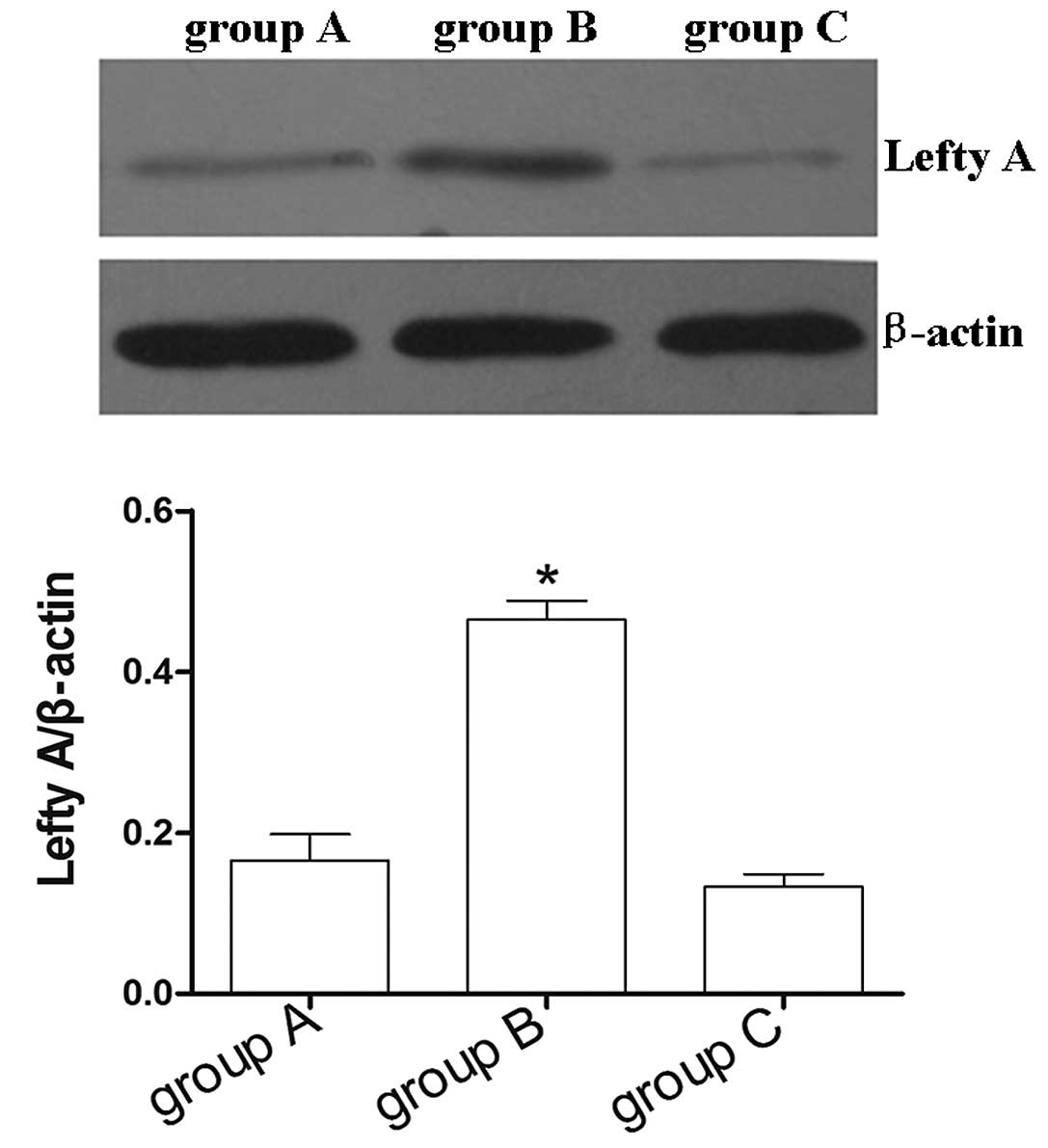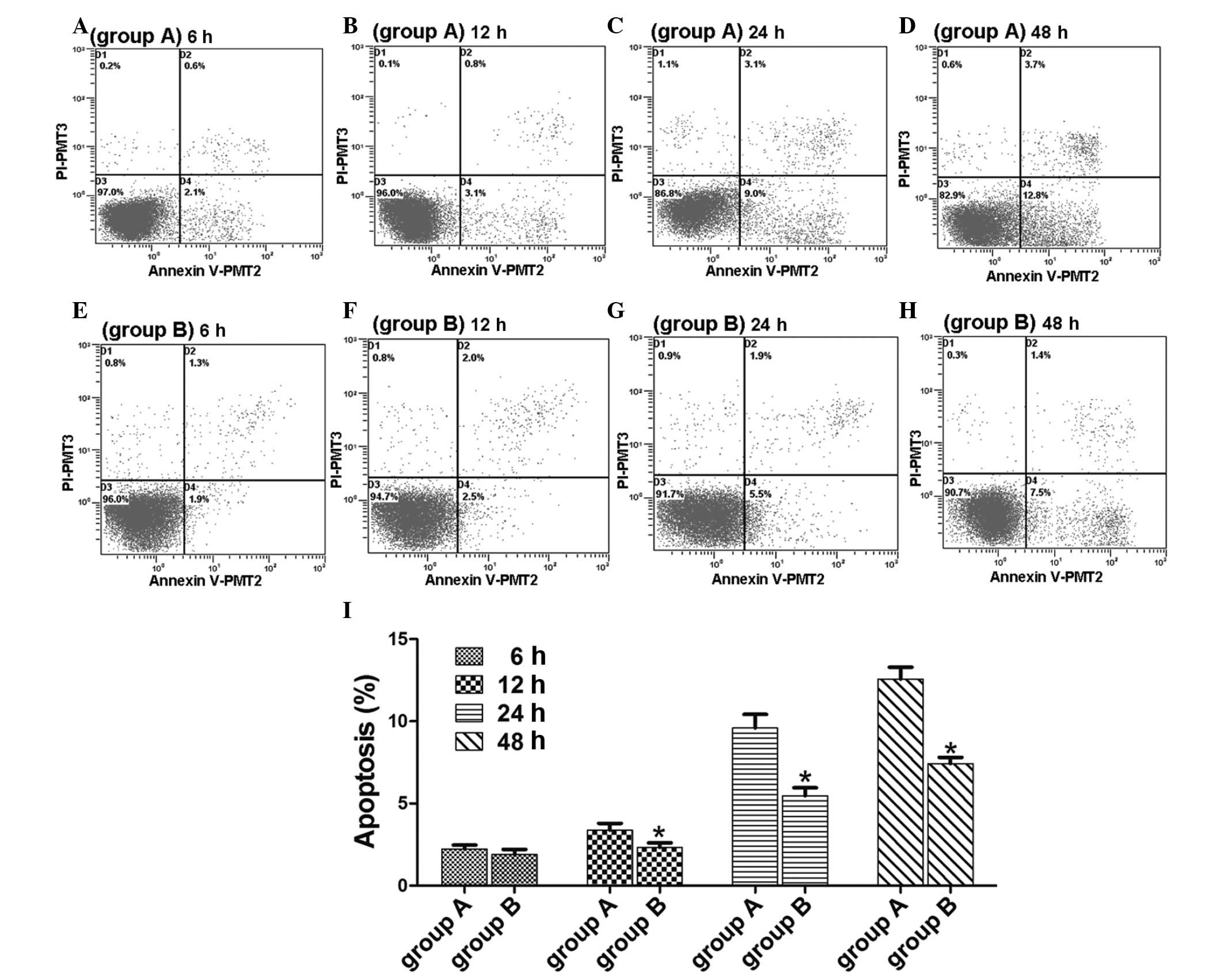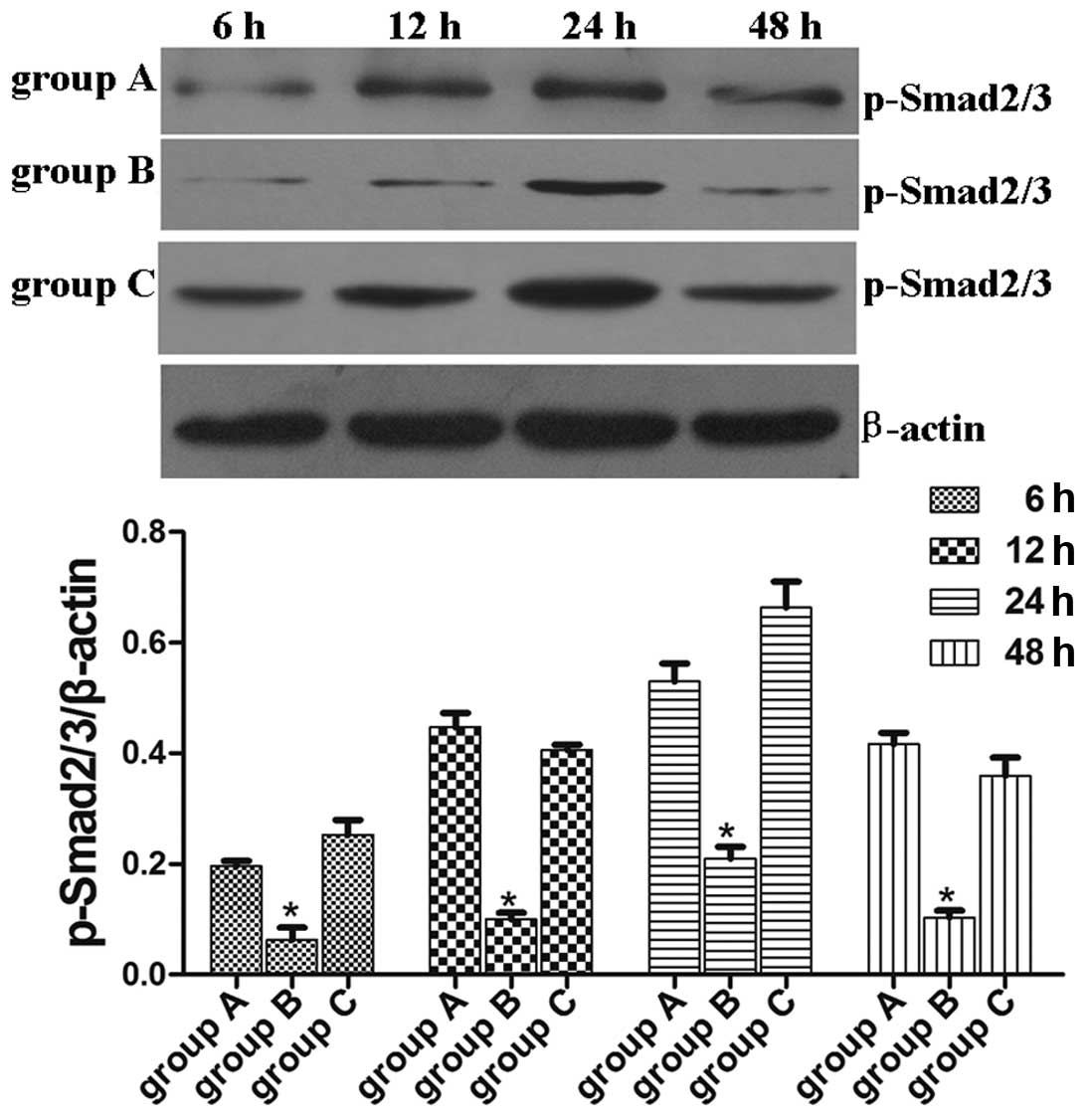Lefty A protein inhibits TGF-β1-mediated apoptosis in human renal tubular epithelial cells
- Authors:
- Published online on: June 26, 2013 https://doi.org/10.3892/mmr.2013.1556
- Pages: 621-625
Abstract
Introduction
By damaging injured or unnecessary cells, apoptosis provides a significant mechanism for maintaining homeostasis and normal biological functions in vivo, and imbalances between cell proliferation and cell death can result in the onset of numerous pathophysiological processes leading to a variety of human diseases (1,2). Excessive apoptosis is important in a number of diseases, including chronic degenerative disease and acquired immune deficiency syndrome. Similarly, inadequate apoptosis contributes to autoimmune disease and cancer (3). Uncontrolled apoptosis is also involved in numerous types of renal disease. Acute renal failure induced by toxic, ischemic or obstructive injury induces apoptosis and necrosis simultaneously in renal tubular epithelial cells (4,5). The excessive loss of tubular cells caused by apoptosis may result in tubular atrophy and tubulointerstitial fibrosis, subsequently leading to a chronic decrease in renal function (6,7).
Transforming growth factor-β1 (TGF-β1) regulates numerous biological functions, including cell proliferation, differentiation, migration and cell death (3). TGF-β1 is capable of regulating apoptosis, positively or negatively, in a cell type- and cellular context-dependent manner as part of a complex signaling system associated with cell survival and apoptosis (3). TGF-β1 also induces apoptosis in a variety of cells, including hepatocytes, epithelial cells, lymphocytes and renal cells (3). Apoptosis of tubular epithelial cells is correlated with TGF-β1 expression, causing tubular atrophy and progressive renal disease, including chronic obstructive nephropathy and diabetic kidney disease (8,9).
Lefty is a novel member of the TGF-β protein superfamily, consisting of Lefty 1 and Lefty 2 in mice (10,11) and their homologs Lefty A and Lefty B in humans (12,13). As one of the most important embryonic signals, Lefty promotes the development of an asymmetric body plan (10,14–16). Unlike other members of the TGF-β superfamily, Lefty does not exist as a dimer. Therefore, it may act as a suppressor of the TGF-β1 signaling pathway (12). Lefty has been shown to inhibit TGF-β1 signaling via inhibition of Smad2/3 phosphorylation and activation of the TGF-β receptor. Additionally, Lefty suppresses the downstream events resulting from R-Smad phosphorylation, including heterodimerization of the R-Smads (Smad2/3) with Smad4 and nuclear translocation of the R-Smad/Smad4 complex (17). In addition, a previous study demonstrated that Lefty A/Ebaf (endometrial bleeding associated factor) significantly reduces the amount of collagen deposited in tissues via inhibition of connective tissue growth factor (CTGF) and collagen type I mRNA synthesis, thus increasing the rates of collagenolysis and elastolysis (18). Therefore, Lefty A may serve as an antagonist for TGF-β1 to ameliorate TGF-β1-induced apoptosis. Current studies of Lefty protein focus on its regulation of individual developmental processes during the embryonic period and its antifibrotic function in adults. To the best of our knowledge, no studies examining the role of Lefty protein with regard to TGF-β1-mediated renal tubular epithelial cell apoptosis have been performed thus far.
This study aimed to examine the effects of Lefty A protein on TGF-β1-mediated renal tubular epithelial cell apoptosis and to investigate the potential mechanisms involved.
Materials and methods
Chemicals and reagents
Human renal tubular epithelial cells (HK-2) were derived from the Beijing Union Cell Culture Center (Beijing, China). DMEM, nutrient mixture F-12 (DMEM/F12), FBS and trypsin/EDTA solution were purchased from Hyclone (Logan, UT, USA). The pcDNA3.1/Hygro (+) plasmid vector was donated by Professor Siamak Tabibzadeh (Stony Brook University, Stony Brook, NY, USA). Chemicals and reagents purchased were: Full-length DNA sequences of human Lefty A (Wuhan Genesil Biotechnology Company, Hubei, China); recombinant human TGF-β1 (PeproTech EC Ltd., London, UK); TRIzol and Lipofectamine™ 2000 (Invitrogen Life Technologies, Carlsbad, CA, USA); First Strand cDNA Synthesis kit (Fermentas, UAB, Lithuania); BCA assay kit (Beyotime Institute of Biotechnology, Jiangsu, China); the monoclonal mouse antibody against Lefty A (R&D Systems, Minneapolis, MN, USA); the polyclonal antibody against p-Smad2/3 and the polyclonal anti-actin antibody (Santa Cruz Biotechnology, Inc., Santa Cruz, CA, USA) and the Annexin V/PI Apoptosis kit (MultiSciences Biotech Co., Ltd., Hangzhou, China).
Plasmid construction
The coding sequence of human Lefty A was amplified from the full-length sequence of Lefty A. The primers used were: sense, 5′-CCCAAGCTT GCCACCATGTGGCCCCTGTGGC-3′, antisense, 5′-CGCG GATCCCTATGGCTGGAGCCTCCTT-3′. The PCR products were digested with restriction endonuclease HindIII and BamHI and inserted into the HindIII and BamHI sites of a pcDNA3.1/Hygro (+) vector. The recombinant plasmid was confirmed by DNA sequencing.
Cell culture and plasmid transfection
HK-2 cells were maintained in DMEM/F12 supplemented with 10% FBS, 100 U/ml penicillin and 100 μg/ml streptomycin at 37°C under a humidified 5% CO2 atmosphere. Cells were seeded in 6-well plates and transfected with 1 μg of either recombinant plasmid DNA or pcDNA3.1 empty vector using Lipofectamine™ 2000. Stable transfectants were generated from a HK-2 cell pool following selection with hygromycin (300 μg/ml). Overexpression of Lefty A in the stable transfected cell line was confirmed by western blot analysis. In order to examine the effects of Lefty A overexpression on TGF-β1-induced apoptosis of human renal tubular epithelial cells, the stably transfected plasmid cell line was cultured in serum-free medium for 24 h prior to TGF-β1 treatment. Cell lysates were harvested 6, 12, 24 and 48 h following treatment with TGF-β1.
Western blotting
The cells were washed with ice-cold PBS and scraped into lysis buffer (150 mM NaCl, 1% NP40, 50 mM Tris/HCl, 1 mM EGTA, 1 mM PMSF, 10 mM Na4P2O7, 10 mM NaF, 1 mM Na3VO5, 10 μg/ml leupeptin and 20 μg/ml aprotinin). The protein concentrations were measured using a BCA assay kit. Following the addition of the protein loading buffer (50 mM Tris/HCl, 10% glycerol, 0.02% BPB, 2% β-mercaptoethanol and 5% SDS, pH 6.8) and denaturation for 5 min at 95°C, 40 μg of total protein from each sample was separated by 8% SDS-PAGE, then transferred onto nitrocellulose membranes. Following blocking in 5% non-fat milk for 1 h at 37°C, the membranes were incubated with various primary antibodies for 24 h at 4°C, followed by a horseradish peroxidase-conjugated secondary antibody for 1 h at room temperature in blocking buffer. Signals were detected using the enhanced chemiluminescence method.
Apoptosis detection by flow cytometry
The samples were washed two or three times and adjusted to a concentration of 1×106 cells/ml with 4°C PBS. Suspensions of 100 μg/l were added to each labeled Falcon tube, and 10 μg/l of annexin V-FITC and 10 μg/l PI (20 μg/ml) were added into labeled Falcon tubes, and incubated for at least 30 min in a dark room at room temperature. Following this, 400 μg/l of PBS buffer was added to each Falcon tube without washing and analyzed using flow cytometry almost immediately (within 20 min). This assay was performed in quintuplicate.
Statistical analysis
Data were expressed as the mean ± SEM from at least three independent experiments. For western blot analysis, quantification was performed by scanning and analyzing the average volume density of the hybridization signals corrected for β-actin using GEL pro3.0 software. Statistical analysis of the data was performed with the Student’s t-test for comparison of the two groups or one-way ANOVA for multiple comparisons. P<0.05 was considered to indicate a statistically significant result.
Results
Expression of Lefty A in HK-2 cells stably transfected with Lefty A
Following a 2 week screening with hygromycin B, non-transfected cells gradually died off. Lefty-positive clone cell islands were observed. The abundance of the Lefty A protein in normal HK-2 cells was extremely low. To examine whether overexpression of Lefty A affects the rate of apoptosis in human renal tubular epithelial cells, a recombinant of the Lefty A plasmid construct was stably transfected into HK-2 cells, and overexpression of the Lefty A was confirmed by western blot analysis. The results demonstrated that the expression levels of Lefty A in HK-2 cells stably transfected with Lefty A were significantly higher compared with normal untransfected HK-2 cell controls and HK-2 cells stably transfected with pcDNA3.1 empty vector (P<0.05; Fig. 1). No evident difference in the expression levels of Lefty A was observed between normal untransfected HK-2 cell controls and HK-2 cells stably transfected with pcDNA3.1 empty vector (Fig. 1).
The apoptotic rate of HK-2 cells stably transfected with Lefty A
No evident cell apoptosis was observed in group A (normal untransfected HK-2 cell control) and group B (HK-2 cells stably transfected with Lefty A) at 6 h following treatment with TGF-β1 and at 12 h, apoptotic rates began to increase (Fig. 2A-H). The apoptotic rate of HK-2 cells stably transfected with Lefty A was significantly lower at each time point than the normal untransfected HK-2 cell controls (P<0.05; Fig. 2I).
Lefty A inhibits the TGF-β1-induced Smad signal transduction pathway
The present study indicates that overexpression of the Lefty A protein notably alleviates TGF-β1-mediated apoptosis in human renal tubular epithelial cells, however, the mechanism by which this occurs remains unknown. As previously observed in stem cells, Lefty A inhibits the TGF-β1-induced Smad signal transduction pathway (2). We investigated whether TGF-β1-induced Smad2/3 activation in HK-2 cells are able to be inhibited by Lefty A. The abundance of p-Smad2/3 protein in normal HK-2 cells was extremely low and TGF-β1 induced activation of p-Smad2/3 in a time-dependent manner with a peak at 24 h. Overexpression of the Lefty A protein inhibited TGF-β1-induced Smad2/3 activation in HK-2 cells, demonstrating that Lefty A is capable of inhibiting the TGF-β1/Smad signaling pathway in the process of TGF-β1-mediated apoptosis in human renal tubular epithelial cells. p-Smad2/3 protein expression levels in group B at each time point were lower than that in groups A and C (HK-2 cells stably transfected with pcDNA3.1 empty vector; P<0.05; Fig. 3). No significant difference in the p-Smad2/3 protein expression levels were observed at each time point between normal untransfected HK-2 cell controls and HK-2 cells stably transfected with pcDNA3.1 empty vector (Fig. 3).
Discussion
As a multifunctional cytokine, TGF-β1 is involved in regulating the cell cycle, cell growth, cell differentiation, matrix formation and cell-mediated apoptosis in a wide range of cells and tissues. A number of studies examining the molecular mechanism involved in renal obstruction disease revealed that TGF-β1 is the key cytokine that mediates cell apoptosis and renal fibrosis. In animal models of unilateral ureteral obstruction (UUO), TGF-β1 antibody reduces the rate of apoptosis in renal tubular epithelial cells (19). In vitro and in vivo studies confirm that TGF-β1 may trigger apoptosis in renal injury (19,20), and Smad proteins are important downstream signal transduction factors for TGF-β1. The Lefty protein was first identifed by Meno et al(11) in the mouse embryo with a left-right asymmetry of protein expression. Lefty is capable of inhibiting the TGF-β1/Smad pathway, particularly the phosphorylation of receptor-activated Smads (R-Smads) in the TGF-β1/Smad pathway and the formation of the R-Smad/co-Smad copolymer.
In the present study, coculture of normal HK-2 cells with TGF-β1 induced elevated expression levels of p-Smad2/3. The phosphorylation of the Smad2/3 proteins forms a key step in the activation of the TGF-β1/Smad pathway. The increased levels of p-Smad2/3 suggest that the activation of the TGF-β1/Smad pathway and higher rates of apoptosis occur simultaneously. No significant difference in p-Smad2/3 expression levels and rate of apoptosis was detected between groups A and C. In group B, liposomes were used to transfect human Lefty A plasmids into HK-2 cells in order to induce the stable expression of endogenous Lefty protein. Following treatment with TGF-β1, the expression levels of p-Smad2/3 and rate of cell apoptosis decreased in group B to a greater degree compared with group A. In vivo and in vitro experiments demonstrate that the TGF-β1/Smad signaling pathway is closely correlated with the rate of apoptosis (21–23). Our study provides consistent results which support this hypothesis. In UUO mouse models, the rate of apoptosis in renal tubular epithelial cells in Smad3-knockout mice was greatly reduced compared with wild-type mice (24). Huang et al(25) observed that high expression levels of Smad7 (TGF-β1/Smad pathway inhibitor) are capable of inhibiting TGF-β1-induced renal tubular cell growth arrest and apoptosis in renal tubular cells transfected with the Smad7 gene.
Taken together, these results indicate that the TGF-β1/Smad signaling pathway is most likely responsible for the regulation of apoptosis in renal tubular epithelial cells. In addition, the Lefty A protein is capable of inhibiting the TGF-β1/Smad pathway in order to reduce TGF-β1/Smad-mediated apoptosis in renal tubular epithelial cells. This study may provide novel insights into the prevention and treatment of urinary tract obstruction disease using the Lefty A protein.
Acknowledgements
This study was supported by a grant from the National Natural Science Foundation of China (no. 81170710).
References
|
Padanilam BJ: Cell death induced by acute renal injury: a perspective on the contributions of apoptosis and necrosis. Am J Physiol Renal Physiol. 284:F608–F627. 2003. View Article : Google Scholar : PubMed/NCBI | |
|
Carson DA and Ribeiro JM: Apoptosis and disease. Lancet. 341:1251–1254. 1993. View Article : Google Scholar : PubMed/NCBI | |
|
Sánchez-Capelo A: Dual role for TGF-beta1 in apoptosis. Cytokine Growth Factor Rev. 16:15–34. 2005. | |
|
Rana A, Sathyanarayana P and Lieberthal W: Role of apoptosis of renal tubular cells in acute renal failure: therapeutic implications. Apoptosis. 6:83–102. 2001. View Article : Google Scholar : PubMed/NCBI | |
|
Havasi A and Borkan SC: Apoptosis and acute kidney injury. Kidney Int. 80:29–40. 2011. View Article : Google Scholar | |
|
Razzaque MS, Ahsan N and Taguchi T: Role of apoptosis in fibrogenesis. Nephron. 90:365–372. 2002. View Article : Google Scholar : PubMed/NCBI | |
|
Zeisberg M, Strutz F and Müller GA: Renal fibrosis: an update. Curr Opin Nephrol Hypertens. 10:315–320. 2001. View Article : Google Scholar | |
|
Böttinger EP and Bitzer M: TGF-beta signaling in renal disease. J Am Soc Nephrol. 13:2600–2610. 2002. | |
|
Kopp JB: TGF-beta signaling and the renal tubular epithelial cell: too much, too little, and just right. J Am Soc Nephrol. 21:1241–1243. 2010. View Article : Google Scholar : PubMed/NCBI | |
|
Meno C, Ito Y, Saijoh Y, et al: Two closely-related left-right asymmetrically expressed genes, lefty-1 and lefty-2: their distinct expression domains, chromosomal linkage and direct neuralizing activity in Xenopus embryos. Genes Cells. 2:513–524. 1997. View Article : Google Scholar | |
|
Meno C, Saijoh Y, Fujii H, et al: Left-right asymmetric expression of the TGF beta-family member lefty in mouse embryos. Nature. 381:151–155. 1996. View Article : Google Scholar : PubMed/NCBI | |
|
Kothapalli R, Buyuksal I, Wu SQ, Chegini N and Tabibzadeh S: Detection of ebaf, a novel human gene of the transforming growth factor beta superfamily association of gene expression with endometrial bleeding. J Clin Invest. 99:2342–2350. 1997. View Article : Google Scholar : PubMed/NCBI | |
|
Kosaki K, Bassi MT, Kosaki R, et al: Characterization and mutation analysis of human LEFTY A and LEFTY B, homologues of murine genes implicated in left-right axis development. Am J Hum Genet. 64:712–721. 1999. View Article : Google Scholar : PubMed/NCBI | |
|
Hamada H, Meno C, Watanabe D and Saijoh Y: Establishment of vertebrate left-right asymmetry. Nat Rev Genet. 3:103–113. 2002. View Article : Google Scholar : PubMed/NCBI | |
|
Dvash T, Mayshar Y, Darr H, et al: Temporal gene expression during differentiation of human embryonic stem cells and embryoid bodies. Hum Reprod. 19:2875–2883. 2004. View Article : Google Scholar : PubMed/NCBI | |
|
Marjoram L and Wright C: Rapid differential transport of Nodal and Lefty on sulfated proteoglycan-rich extracellular matrix regulates left-right asymmetry in Xenopus. Development. 138:475–485. 2011. View Article : Google Scholar : PubMed/NCBI | |
|
Ulloa L and Tabibzadeh S: Lefty inhibits receptor-regulated Smad phosphorylation induced by the activated transforming growth factor-beta receptor. J Biol Chem. 276:21397–21404. 2001. View Article : Google Scholar : PubMed/NCBI | |
|
Mason JM, Xu HP, Rao SK, et al: Lefty contributes to the remodeling of extracellular matrix by inhibition of connective tissue growth factor and collagen mRNA expression and increased proteolytic activity in a fibrosarcoma model. J Biol Chem. 277:407–415. 2002. View Article : Google Scholar | |
|
Miyajima A, Chen J, Lawrence C, et al: Antibody to transforming growth factor-beta ameliorates tubular apoptosis in unilateral ureteral obstruction. Kidney Int. 58:2301–2313. 2000. View Article : Google Scholar : PubMed/NCBI | |
|
Dai C, Yang J and Liu Y: Transforming growth factor-beta1 potentiates renal tubular epithelial cell death by a mechanism independent of Smad signaling. J Biol Chem. 278:12537–12545. 2003. View Article : Google Scholar : PubMed/NCBI | |
|
Li Y, Ge Y, Liu FY, et al: Norcantharidin, a protective therapeutic agent in renal tubulointerstitial fibrosis. Mol Cell Biochem. 361:79–83. 2012. View Article : Google Scholar : PubMed/NCBI | |
|
Wang X, Sun W, Zhang C, et al: TGF-beta1 inhibits the growth and metastasis of tongue squamous carcinoma cells through Smad4. Gene. 485:160–166. 2011. View Article : Google Scholar : PubMed/NCBI | |
|
Li J, Deane JA, Campanale NV, Bertram JF and Ricardo SD: Blockade of p38 mitogen-activated protein kinase and TGF-beta1/Smad signaling pathways rescues bone marrow-derived peritubular capillary endothelial cells in adriamycin-induced nephrosis. J Am Soc Nephrol. 17:2799–2811. 2006. View Article : Google Scholar | |
|
Inazaki K, Kanamaru Y, Kojima Y, et al: Smad3 deficiency attenuates renal fibrosis, inflammation, and apoptosis after unilateral ureteral obstruction. Kidney Int. 66:597–604. 2004. View Article : Google Scholar : PubMed/NCBI | |
|
Huang YJ, Mei YM, Wang YQ, et al: Transfection and expression of Smad7 inhibits transforming growth factor-β1 effects on renal tubular cells (Chinese). J Third Military Medical University. 25:1049–1052. 2003. |












